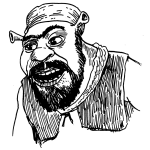DUB, DUB, AND REDUB
Downtown Tehran, winter: impossible traffic, the energy of 9 million Iranians making their way through congested streets, the white peaks of the Alborz Mountains disappearing shade by shade in the ever-increasing smog. The government’s declared another pollution emergency, and the center city is closed to license plates ending in odd numbers. The students at the university, where I am teaching a seminar on American Studies, are complaining openly about the failures of their elected officials.
Nahal1 and I are sitting in a café off Haft-e Tir Square. She is smart and dynamic, a graduate student and freelance journalist who is quick to criticize the US government and the perfidy of CNN. When I mention that, a few days ago, I had overheard Friday prayers and was taken aback by the chanting of Marg bar Amrika! (“Death to America”) she retorts: “But you call us the Axis of Evil!”
Our conversation turns to the movie Shrek. Nahal loves Shrek so much that she’s seen the first installment of the DreamWorks trilogy “at least thirty-six or thirty-seven times.” Her obsession is, apparently, shared by many Iranians. The image of Shrek appears everywhere throughout Tehran: painted on the walls of DVD and electronics shops, featured in an elaborate mural in the children’s play area of the food court at the Jaam-e Jam mall. Once, from a car, I passed a five-foot-tall Shrek mannequin on the sidewalk; like his fellow pedestrians, he wore a surgical face mask to protect him from the smog.
Nahal explains: “You know, it’s not really the original Shrek that we love so much here. It’s really the dubbing. It’s really more the Iranian Shrek that interests us.”
The Iranian film industry has a long and illustrious tradition of high-quality dubbings. In the post-Revolution era, and the ensuing rise of censorship, dubbing has evolved to become a form of underground art, as well as a meta-commentary on Iranians’ attempt to adapt, and in some way lay claim to, the products of Western culture. A single American film like Shrek inspires multiple dubbed versions—some illegal, some not—causing Iranians to discuss and debate which of the many Farsi Shreks is superior. In some versions (since withdrawn from official circulation), various regional and ethnic accents are paired with the diverse characters of Shrek, the stereotypes associated with each accent adding an additional layer of humor for Iranians. In the more risqué bootlegs, obscene or off-topic conversations are transposed over Shrek’s fairy-tale shenanigans.
But still, I asked her, why Shrek, of all things? Was it the racially coded...
You have reached your article limit
Sign up for a digital subscription and continue reading all new issues, plus our entire archives, for just $1.50/month.
Already a subscriber? Sign in





